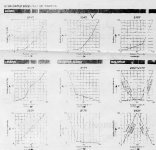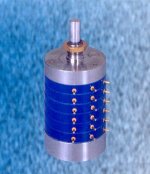Thanks Peter, I'm currently using some old Allen-Bradley pots and I like them quite a bit. Maybe a group order would be in order for some stereo PEC pots... An idea, wonder if it'll ever get done, I dunno...
I don't know how many log pots did you open, but the ones I've seen inside are done nothing like they say.
I'm doing this from memory, but best I can recall is that looking at the data sheets that show the taper graphically the "log" tapers pretty much conform to what Rod claims. In fact, the only gaph I recall that looked like a real log curve was some sort of digital pot.
That aside, this tread motivated me to dig out an old Bournes dual gang 100k-ohm pot that been sitting in my garage for some time. I probably paid US$5-10 for it. The end-to-end resistance was 83k and 87k. That's within the 20% tolerance overall, but the difference between gangs is ~5%, much less than 1dB. Checking the end-to-wiper resistance at half a dozen positions, the difference between gangs remained ~5% or better except near low end. In actual use, it would have been quite close in the most used range of positions.
But what was really interesting was when I used the resistance readings above and the voltage divider formula to calculate the relative differences between the resulting out-voltages at each position from a 1V input voltage. They were a tiny, tiny fraction of a dB different! This is a totally unexpected result. In fact, I feel compelled to check this further on other "junk pots", including applying actual voltages rather than just calculations to see if that confirms the above.
Temporary speculation: the spec sheets for both US$10 and US$1,000 are wildly pessamistic and comparrissons between them may be a wasted effort. Is it possible that as far as R vs. L matching of voltages at the pot outputs the real situation is much better than one would assume from spec sheets even for the cheapos? Perhaps the value added with more expensive pots lies in longer life, lower noise (certainly when changing the position of aged ones!), better/smoother feel, etc.
Damn this thread -- now I don't trust any of my past assumptions without further investigation!
Is nice to see here talking about " sound of pots ", although pot is passive device. Have you explanation for this ?
sam9 said:
I'm doing this from memory, but best I can recall is that looking at the data sheets that show the taper graphically the "log" tapers pretty much conform to what Rod claims. In fact, the only gaph I recall that looked like a real log curve was some sort of digital pot.
Damn this thread -- now I don't trust any of my past assumptions without further investigation!
Here you are, the graphs for Nobel. Sorry for bad copy, but I got it by fax.
Those curves are actually pretty accurate. I went through 60 detented mono pots (36 positions). They all measured very close and actually there was no problem matching them in pairs, with less than 0.5db error on each consequentive detent position. I was matching them using signal generator and true dB meter, making readings every 5 steps and noting the value. I did that for Amp-1 implementation.
Attachments
Sigurd
Instead of paying big bucks for this you should consider Penny and Giles RF-11 or RF-15 series.
A legend in Pro-Audio and studio type pots...
Luk123
Instead of paying big bucks for this you should consider Penny and Giles RF-11 or RF-15 series.
A legend in Pro-Audio and studio type pots...
Luk123
I can't make out the charts very well (poor image) but I'll accept what you say that they track well. I note some curves that have "kinks" in them - I think those might be examples of log/audio tapers constructed from two or three linear sections. If so, they are no doubt reasonably close to a true log curvre
Thanks for all the input, guys!
I have done a rather in depth research about attenuators the last 4 weeks, and my conclusion is that I will not use the RK-50.
My plan now is to use a medium priced pot a la Penny&Giles or the TKD2500 from thelaudio in Germany for the prototype,
but in the final product I will use a stepped attenuator using high precision, high-quality resistors and relais.
The attenuator will be remote controlled.
Most high-end audio manufacturers have stopped using pots. They use stepped attenuators with relais.
Sigurd
I have done a rather in depth research about attenuators the last 4 weeks, and my conclusion is that I will not use the RK-50.
My plan now is to use a medium priced pot a la Penny&Giles or the TKD2500 from thelaudio in Germany for the prototype,
but in the final product I will use a stepped attenuator using high precision, high-quality resistors and relais.
The attenuator will be remote controlled.
Most high-end audio manufacturers have stopped using pots. They use stepped attenuators with relais.
Sigurd
Gasho said:I vote for Penny + Giles pots. They are best in the world!
Hi Gasho! Nice to see you around here!!
And where can we from ex-Yu purchase those pots? And aproximate price range of them!?
Thanks
Member
Joined 2009
Paid Member
Most high-end audio manufacturers have stopped using pots. They use stepped attenuators with relais.Sigurd
Because it sounds better or for another reason ? (marketing, reliability, ease of remote control)
- Status
- Not open for further replies.
- Home
- Design & Build
- Parts
- ALPS RK50 - Is this the best volume pot in the world?

